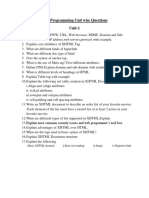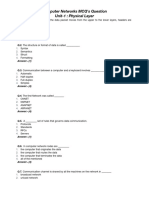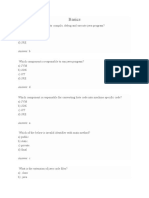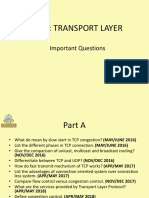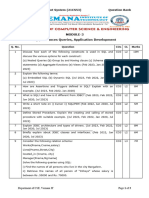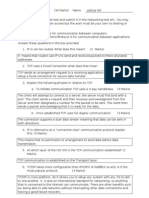0 ratings0% found this document useful (0 votes)
968 viewsNetwork Layer Imp Questions
This document contains important questions about the network layer. It asks about key topics like packet switching, subnetting, IP addressing, IPv4 and IPv6 protocols, DHCP, ICMP, ARP, RARP, and the differences between packet switching and circuit switching. Part A focuses on definition and short answer questions, while Part B asks for more in-depth explanations of topics like packet switching, IP addressing methods, DHCP, ICMP, IPv6, and address resolution protocols.
Uploaded by
CSE 14 Maria NaveenCopyright
© © All Rights Reserved
Available Formats
Download as PDF, TXT or read online on Scribd
0 ratings0% found this document useful (0 votes)
968 viewsNetwork Layer Imp Questions
This document contains important questions about the network layer. It asks about key topics like packet switching, subnetting, IP addressing, IPv4 and IPv6 protocols, DHCP, ICMP, ARP, RARP, and the differences between packet switching and circuit switching. Part A focuses on definition and short answer questions, while Part B asks for more in-depth explanations of topics like packet switching, IP addressing methods, DHCP, ICMP, IPv6, and address resolution protocols.
Uploaded by
CSE 14 Maria NaveenCopyright
© © All Rights Reserved
Available Formats
Download as PDF, TXT or read online on Scribd
You are on page 1/ 1
CS3591-Computer Networks
Unit -3 Network Layer
Important questions
Part-A:
1. What is packet switching?
2. What is subnetting?
3. What is subnet mask?
4. Define CIDR.
5. How many network addresses and host addresses are supported by class A,
class B networks?
6. List out the functions of IP.
7. What is IP address?
8. Explain IPV6 protocol. Why IPV6 is preferred over IPV4?
9. What is DHCP?
10. Explain IPV4 protocol.
11. Present an outline of IPv6 addressing.
12. What are the differences between IPV4 and IPV6?
13. What do you mean by ICMP?
14. Compare ARP and RARP
15. What is the need of ARP?
16. Define RARP.
17. List the difference between Packet Switching and Circuit Switching.
18. Why is IPV4 to IPV6 transition required?
Part-B:
1. Explain Packet Switching in detail.
2. i) Discuss the IP addressing methods.
ii) Write short notes on ARP.
3. Explain in detail about DHCP.
4. What is the need for ICMP? Mention ICMP MESSAGES and their
purpose.
5. Explain about IPV6? Compare IPV4 and IPV6
6. Discuss about address Resolution protocols.
7. Explain in detail about: i) ICMP ii) ARP iii) RARP.
8. Explain IPv4 packet format and how fragmentation is applied in
datagram delivery.
You might also like
- Data Communication Chapter 1 Questions and ProblemsNo ratings yetData Communication Chapter 1 Questions and Problems3 pages
- Web Programming Unit Wise Questions Unit-1No ratings yetWeb Programming Unit Wise Questions Unit-15 pages
- 18cse381t - Cryptography Question Bank CseNo ratings yet18cse381t - Cryptography Question Bank Cse33 pages
- Ec2352 Computer Networks Anna University Previous Year Question Paper100% (1)Ec2352 Computer Networks Anna University Previous Year Question Paper2 pages
- Design and Analysis of Algorithms: Lab ManualNo ratings yetDesign and Analysis of Algorithms: Lab Manual57 pages
- Data Communication and Computer Network Set 1No ratings yetData Communication and Computer Network Set 15 pages
- CCN Sample MCQ & Question Bank For Descriptive Questions Sample MCQNo ratings yetCCN Sample MCQ & Question Bank For Descriptive Questions Sample MCQ2 pages
- CS2302 Computer Networks Anna University Engineering Question Bank 4 UNo ratings yetCS2302 Computer Networks Anna University Engineering Question Bank 4 U48 pages
- Mobile Computing - Lecture Notes, Study Material and Important Questions, AnswersNo ratings yetMobile Computing - Lecture Notes, Study Material and Important Questions, Answers4 pages
- Distributed Systems Question Paper JNTUHNo ratings yetDistributed Systems Question Paper JNTUH2 pages
- Loyola-Icam College of Engineering and Technology (LICET)No ratings yetLoyola-Icam College of Engineering and Technology (LICET)2 pages
- Design and Analysis of Algorithms Question Bank100% (1)Design and Analysis of Algorithms Question Bank10 pages
- CH 14 Wireless LANs Multiple Choice Questions and Answers MCQ PDF - Data Communication and Networking PDFNo ratings yetCH 14 Wireless LANs Multiple Choice Questions and Answers MCQ PDF - Data Communication and Networking PDF13 pages
- Unit Iv: Transport Layer: Important QuestionsNo ratings yetUnit Iv: Transport Layer: Important Questions3 pages
- Unit 1 Algorithm Performance Analysis and MeasurementNo ratings yetUnit 1 Algorithm Performance Analysis and Measurement61 pages
- Important Questions Computer Networks: Question BankNo ratings yetImportant Questions Computer Networks: Question Bank2 pages
- Question Bank Module 1: An Overview of JavaNo ratings yetQuestion Bank Module 1: An Overview of Java4 pages
- Locating Mobile Entities in Distributed Systems67% (3)Locating Mobile Entities in Distributed Systems2 pages
- Top Viva Questions On Asymptotic NotationsNo ratings yetTop Viva Questions On Asymptotic Notations3 pages
- Mobile Computing Question Paper For JntuNo ratings yetMobile Computing Question Paper For Jntu4 pages
- CH 30 Cryptography Multiple Choice Questions and Answers PDF100% (2)CH 30 Cryptography Multiple Choice Questions and Answers PDF9 pages
- Anna University OOPS Question Bank Unit 2No ratings yetAnna University OOPS Question Bank Unit 26 pages
- 21CS53 DBMS Module3 QuestionBank 2023-24No ratings yet21CS53 DBMS Module3 QuestionBank 2023-243 pages




